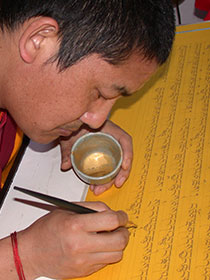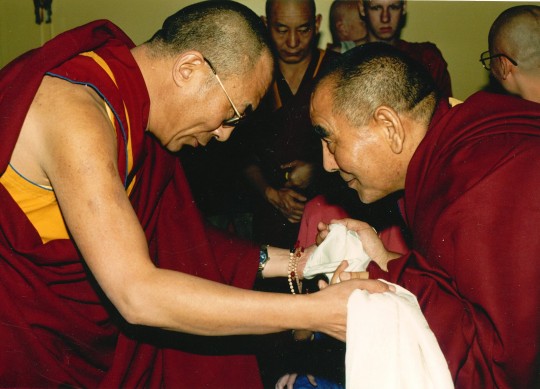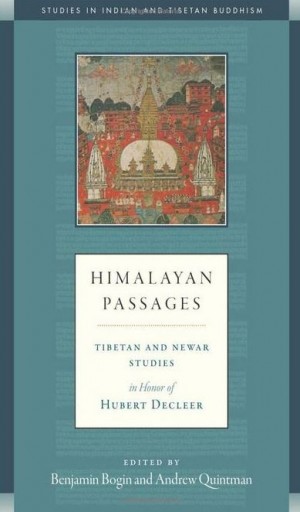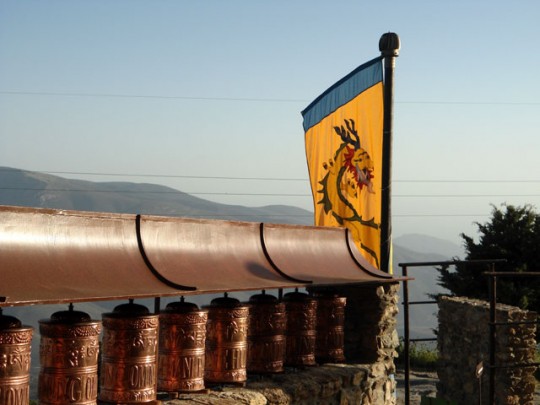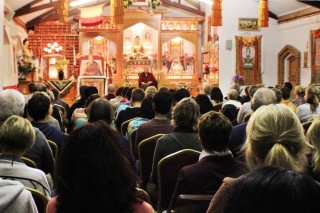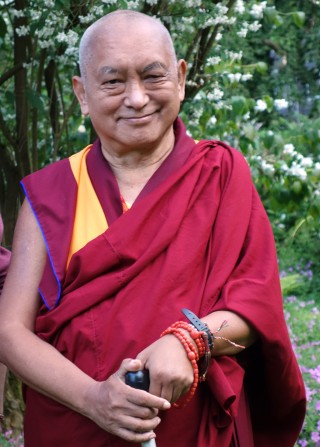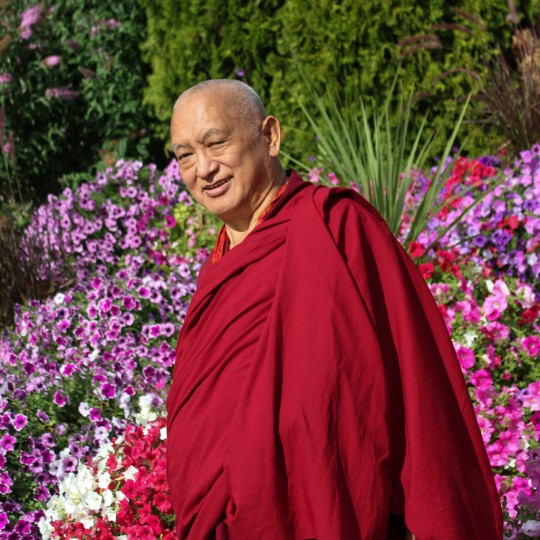- Home
- FPMT Homepage
Foundation for the Preservation of the Mahayana Tradition
The FPMT is an organization devoted to preserving and spreading Mahayana Buddhism worldwide by creating opportunities to listen, reflect, meditate, practice and actualize the unmistaken teachings of the Buddha and based on that experience spreading the Dharma to sentient beings. We provide integrated education through which people’s minds and hearts can be transformed into their highest potential for the benefit of others, inspired by an attitude of universal responsibility and service. We are committed to creating harmonious environments and helping all beings develop their full potential of infinite wisdom and compassion. Our organization is based on the Buddhist tradition of Lama Tsongkhapa of Tibet as taught to us by our founders Lama Thubten Yeshe and Lama Thubten Zopa Rinpoche.
- Willkommen
Die Stiftung zur Erhaltung der Mahayana Tradition (FPMT) ist eine Organisation, die sich weltweit für die Erhaltung und Verbreitung des Mahayana-Buddhismus einsetzt, indem sie Möglichkeiten schafft, den makellosen Lehren des Buddha zuzuhören, über sie zur reflektieren und zu meditieren und auf der Grundlage dieser Erfahrung das Dharma unter den Lebewesen zu verbreiten.
Wir bieten integrierte Schulungswege an, durch denen der Geist und das Herz der Menschen in ihr höchstes Potential verwandelt werden zum Wohl der anderen – inspiriert durch eine Haltung der universellen Verantwortung und dem Wunsch zu dienen. Wir haben uns verpflichtet, harmonische Umgebungen zu schaffen und allen Wesen zu helfen, ihr volles Potenzial unendlicher Weisheit und grenzenlosen Mitgefühls zu verwirklichen.
Unsere Organisation basiert auf der buddhistischen Tradition von Lama Tsongkhapa von Tibet, so wie sie uns von unseren Gründern Lama Thubten Yeshe und Lama Thubten Zopa Rinpoche gelehrt wird.
- Bienvenidos
La Fundación para la preservación de la tradición Mahayana (FPMT) es una organización que se dedica a preservar y difundir el budismo Mahayana en todo el mundo, creando oportunidades para escuchar, reflexionar, meditar, practicar y actualizar las enseñanzas inconfundibles de Buda y en base a esa experiencia difundir el Dharma a los seres.
Proporcionamos una educación integrada a través de la cual las mentes y los corazones de las personas se pueden transformar en su mayor potencial para el beneficio de los demás, inspirados por una actitud de responsabilidad y servicio universales. Estamos comprometidos a crear ambientes armoniosos y ayudar a todos los seres a desarrollar todo su potencial de infinita sabiduría y compasión.
Nuestra organización se basa en la tradición budista de Lama Tsongkhapa del Tíbet como nos lo enseñaron nuestros fundadores Lama Thubten Yeshe y Lama Zopa Rinpoche.
A continuación puede ver una lista de los centros y sus páginas web en su lengua preferida.
- Bienvenue
L’organisation de la FPMT a pour vocation la préservation et la diffusion du bouddhisme du mahayana dans le monde entier. Elle offre l’opportunité d’écouter, de réfléchir, de méditer, de pratiquer et de réaliser les enseignements excellents du Bouddha, pour ensuite transmettre le Dharma à tous les êtres. Nous proposons une formation intégrée grâce à laquelle le cœur et l’esprit de chacun peuvent accomplir leur potentiel le plus élevé pour le bien d’autrui, inspirés par le sens du service et une responsabilité universelle. Nous nous engageons à créer un environnement harmonieux et à aider tous les êtres à épanouir leur potentiel illimité de compassion et de sagesse. Notre organisation s’appuie sur la tradition guéloukpa de Lama Tsongkhapa du Tibet, telle qu’elle a été enseignée par nos fondateurs Lama Thoubtèn Yéshé et Lama Zopa Rinpoché.
Visitez le site de notre Editions Mahayana pour les traductions, conseils et nouvelles du Bureau international en français.
Voici une liste de centres et de leurs sites dans votre langue préférée
- Benvenuto
L’FPMT è un organizzazione il cui scopo è preservare e diffondere il Buddhismo Mahayana nel mondo, creando occasioni di ascolto, riflessione, meditazione e pratica dei perfetti insegnamenti del Buddha, al fine di attualizzare e diffondere il Dharma fra tutti gli esseri senzienti.
Offriamo un’educazione integrata, che può trasformare la mente e i cuori delle persone nel loro massimo potenziale, per il beneficio di tutti gli esseri, ispirati da un’attitudine di responsabilità universale e di servizio.
Il nostro obiettivo è quello di creare contesti armoniosi e aiutare tutti gli esseri a sviluppare in modo completo le proprie potenzialità di infinita saggezza e compassione.
La nostra organizzazione si basa sulla tradizione buddhista di Lama Tsongkhapa del Tibet, così come ci è stata insegnata dai nostri fondatori Lama Thubten Yeshe e Lama Zopa Rinpoche.
Di seguito potete trovare un elenco dei centri e dei loro siti nella lingua da voi prescelta.
- 欢迎 / 歡迎
简体中文
“护持大乘法脉基金会”( 英文简称:FPMT。全名:Foundation for the Preservation of the Mahayana Tradition) 是一个致力于护持和弘扬大乘佛法的国际佛教组织。我们提供听闻,思维,禅修,修行和实证佛陀无误教法的机会,以便让一切众生都能够享受佛法的指引和滋润。
我们全力创造和谐融洽的环境, 为人们提供解行并重的完整佛法教育,以便启发内在的环宇悲心及责任心,并开发内心所蕴藏的巨大潜能 — 无限的智慧与悲心 — 以便利益和服务一切有情。
FPMT的创办人是图腾耶喜喇嘛和喇嘛梭巴仁波切。我们所修习的是由两位上师所教导的,西藏喀巴大师的佛法传承。
繁體中文
護持大乘法脈基金會”( 英文簡稱:FPMT。全名:Found
ation for the Preservation of the Mahayana Tradition ) 是一個致力於護持和弘揚大乘佛法的國際佛教組織。我們提供聽聞, 思維,禪修,修行和實證佛陀無誤教法的機會,以便讓一切眾生都能 夠享受佛法的指引和滋潤。 我們全力創造和諧融洽的環境,
為人們提供解行並重的完整佛法教育,以便啟發內在的環宇悲心及責 任心,並開發內心所蘊藏的巨大潛能 — 無限的智慧與悲心 – – 以便利益和服務一切有情。 FPMT的創辦人是圖騰耶喜喇嘛和喇嘛梭巴仁波切。
我們所修習的是由兩位上師所教導的,西藏喀巴大師的佛法傳承。 察看道场信息:
- FPMT Homepage
- News/Media
-
- Study & Practice
-
-
- About FPMT Education Services
- Latest News
- Programs
- New to Buddhism?
- Buddhist Mind Science: Activating Your Potential
- Heart Advice for Death and Dying
- Discovering Buddhism
- Living in the Path
- Exploring Buddhism
- FPMT Basic Program
- FPMT Masters Program
- FPMT In-Depth Meditation Training
- Maitripa College
- Lotsawa Rinchen Zangpo Translator Program
- Universal Education for Compassion & Wisdom
- Online Learning Center
-
- Prayers & Practice Materials
- Overview of Prayers & Practices
- Full Catalogue of Prayers & Practice Materials
- Explore Popular Topics
- Benefiting Animals
- Chenrezig Resources
- Death & Dying Resources
- Lama Chopa (Guru Puja)
- Lama Zopa Rinpoche: Compendium of Precious Instructions
- Lama Zopa Rinpoche: Life Practice Advice
- Lama Zopa Rinpoche Practice Series
- Lamrim Resources
- Mantras
- Prayer Book Updates
- Purification Practices
- Sutras
- Thought Transformation (Lojong)
- Audio Materials
- Dharma Dates - Tibetan Calendar
- Translation Services
- Publishing Services
- Ways to Offer Support
- Prayers & Practice Materials
-
- Teachings and Advice
- Find Teachings and Advice
- Lama Zopa Rinpoche Advice Page
- Lama Zopa Rinpoche: Compendium of Precious Instructions
- Lama Zopa Rinpoche Video Teachings
- ༧སྐྱབས་རྗེ་བཟོད་པ་རིན་པོ་ཆེ་མཆོག་ནས་སྩལ་བའི་བཀའ་སློབ་བརྙན་འཕྲིན།
- Podcasts
- Lama Yeshe Wisdom Archive
- Buddhism FAQ
- Dharma for Young People
- Resources on Holy Objects
- Teachings and Advice
-
-
*If a menu item has a submenu clicking once will expand the menu clicking twice will open the page.
-
-
- Centers
-
- Teachers
-
- Projects
-
-
-
-
*If a menu item has a submenu clicking once will expand the menu clicking twice will open the page.
-
-
- FPMT
-
-
-
-
-
Don’t think of Buddhism as some kind of narrow, closed-minded belief system. It isn’t. Buddhist doctrine is not a historical fabrication derived through imagination and mental speculation, but an accurate psychological explanation of the actual nature of the mind.
Lama Thubten Yeshe
-
-
-
- Shop
-
-
-
The Foundation Store is FPMT’s online shop and features a vast selection of Buddhist study and practice materials written or recommended by our lineage gurus. These items include homestudy programs, prayers and practices in PDF or eBook format, materials for children, and other resources to support practitioners.
Items displayed in the shop are made available for Dharma practice and educational purposes, and never for the purpose of profiting from their sale. Please read FPMT Foundation Store Policy Regarding Dharma Items for more information.
-
-
Mandala
3
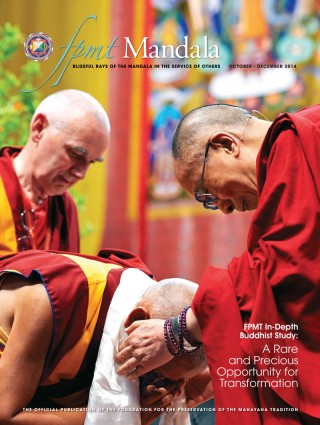 The new issue of Mandala magazine, October-December 2014, is in the mail and the supplemental online content is published!
The new issue of Mandala magazine, October-December 2014, is in the mail and the supplemental online content is published!
In this print issue, graduates of FPMT’s in-depth Buddhist studies programs talk about transformation and the power of in-depth study. We also share new, unpublished teachings from Lama Yeshe and Lama Zopa Rinpoche, plus a report on His Holiness the Dalai Lama’s visit to Istituto Lama Tzong Khapa in Italy.
If you’d like to receive Mandala directly, consider supporting Friends of FPMT, which gives you complete access to Mandala as quickly as possible as well as access to the FPMT Online Learning Center.
Be sure to peruse this issue’s online edition, which includes:
- Lama Zopa Rinpoche on the benefits of the Golden Light Sutra,
- “Origin and Spread of the Buddha’s Doctrine,” an excerpt from Buddhism: One Teacher, Many Traditions by His Holiness the Dalai Lama and Ven. Thubten Chodron, published by Wisdom Publications,
- An interview with Ven. Thubten Chodron about the new book Buddhism: One Teacher, Many Traditions,
- Ven. Chönyi Taylor’s new Dharma Realities column: “Procrastination,”
- “You Are Not Alone” by Namdrol Miranda Adams and other homilies from Maitripa College students,
- Plus much more.
Mandala brings you news of Lama Zopa Rinpoche and FPMT activities, teachers and events from over 160 FPMT centers, projects and services around the globe. If you have news you would like to share, please let us know.
2
By Ven. Chönyi Taylor
“Procrastination is my sin.
It brings me naught but sorrow.
I know that I should stop it.
In fact, I will – tomorrow!”
– Gloria Pitzer
I have been diverting myself with countless other activities, both time-wasting and beneficial instead of writing this blog. I’m in the process of procrastination. However, this blog has a deadline and I am already past that. It was Douglas Adams, who said, “I love deadlines. I like the whooshing sound they make as they go by.” I am in eminent company. Procrastination is about putting off what is important. Going to the dentist, or studying for exams, or fixing the leaking tap can all be objects for procrastination. The real question is: what are we avoiding by procrastinating?
Procrastination is an interesting phenomenon. It is partly a function of motivation, or rather, lack of motivation, and partly a function of priorities, or poorly organized priorities. One famous Buddhist procrastinator was Ananda, a direct disciple of Shakyamuni Buddha. When the Buddha was dying, he said to Ananda that the Sangha could abolish the minor ordination vows. Of course, Ananda was going to check with Buddha which rules were minor and which major. However, he put off asking. No doubt, Ananda kept saying, “Not just now. I’ll ask later.” Buddha died. We still do not know which are major and which are minor vows because Ananda never checked. I can just imagine Ananda saying, “Well, I was going to ask, but ….” To be safe, we take them all. To this day, our monastic vows are based on what was relevant 2,500 years ago.
How many procrastinators does it take to screw in a light bulb?
One. But he has to wait until the light is better.
Procrastination comes from the Latin procrastinatus, where pro- ”forward” combines with crastinus, meaning “tomorrow.” In other words, we are in favor of tomorrow and not today. We will get it done tomorrow, which of course is never today. Are we just being lazy? Yes, according to Buddhist teachings. Western psychology has various theories about the causes of procrastination, none of which refer to laziness. Rather, the causes are seen to be disorganization, perfectionism, anxiety, or just plain irrational thinking. So where does laziness come in? Laziness implies we do not care, but when we procrastinate, we do care, perhaps too deeply and for the wrong things. Laziness, like addiction, argues that our short-term pleasure is preferable to facing up to reality. Laziness is about luxuriating in what our self-cherishing calls pleasure, and that is none other than one of the three root faults: attachment.
Really, we procrastinators are like addicts who know what we are doing (procrastinating) is causing problems, but do it (or, do not do “it,” i.e., what we ought to be doing), anyway. So it boils down to this: when the “pleasure” of procrastination is less than the pleasure of completing the task, then we get on with it. Or to put it another way: when the disadvantages of not completing the task are worse than the disadvantages of procrastination. I prefer the positive spin.
My dog does not let me procrastinate when it comes to feeding him or walking him. He has his own way of expressing his impatience. Sitting on my feet is one of his strategies, or pointedly looking at the door. If I still don’t respond, then he gives a little cough, which slowly develops into a louder and louder bark. He makes sure I will be motivated, if only by annoying me. He makes sure I prioritize his needs. The pleasure of sitting in my chair has become overwhelmed by the displeasure of my persistent dog.
There is plenty of advice on the web about how to overcome procrastination or laziness. My own experience is that a hit of reality, like my barking dog, is the best solution. As far as this blog is concerned, that hit of reality is the deadline which has already passed. Such hits of reality seriously erode the pleasure of procrastinating. My biggest hit of reality came recently. My body told me on no uncertain terms that I am not immortal, that one day I really will die. That day could be tomorrow or in 10 year’s time, but my body reminded me, rather forcefully, that it will not last forever. And I know that if I am going to die, then I prefer to die well.
It is not so much that with death I fear discarding my current body. My body leaves a lot to be desired anyway. It is more that I would like a nice rebirth in my next body. That means being reborn as a human with access to wisdom and compassion: what we call a precious human rebirth. Or a rebirth in a pure realm would do me nicely with not even a deteriorating human body to worry about. So how to get there? Well, by practicing the teachings now, which means through generating positive karma while I can. I do not think that procrastination will help.
“You must not procrastinate. Rather, you should make preparations so that even if you did die tonight, you would have no regrets. If you develop an appreciation for the uncertainty and imminence of death, your sense of the importance of using your time wisely will get stronger and stronger.”
– His Holiness the Dalai Lama
Thinking about death is like having the dog nagging you. You cannot get away from it easily without taking some action. It’s a most powerful motivator.
Ven. Chönyi Taylor is a registered Foundational Buddhism FPMT teacher and an elder for the Discovering Buddhism at Home Course. She is the author of Enough! A Buddhist Approach to Working with Addictive Patterns (Snow Lion, 2010) and has been published in Mandala, Buddhadharma, Dharma Vision and Sangha Magazine. She is a founding member and member of the training committee of the Australian Association of Buddhist Counsellors and Psychotherapists and an Honorary Lecturer in the Discipline of Psychiatry at Sydney University.
- Tagged: mandala, ven. chonyi taylor
- 0
29
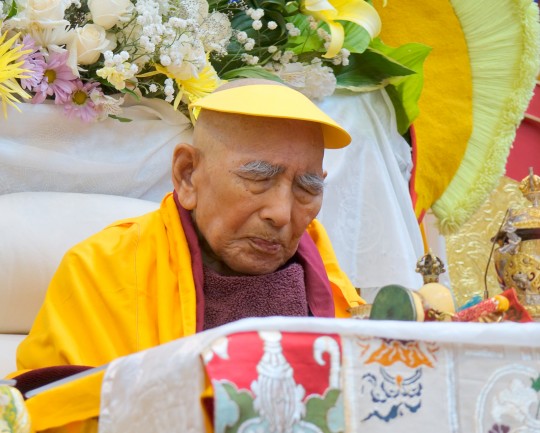
Geshe Sopa Rinpoche during long life puja, Deer Park Buddhist Center, Wisconsin, US, July 20, 2014. Photo by Ven. Roger Kunsang.
Geshe Lhundub Sopa Rinpoche passed into clear light meditation on August 28 at Deer Park Buddhist Center in Oregon, Wisconsin, US. Geshe Sopa was a preeminent scholar of Tibetan Buddhism, a gifted teacher and an embodiment of the qualities of humility, tolerance and compassion.
Born in 1923 in Tsang, Tibet, to poor farmers, Geshe Sopa took novice vows and entered Ganden Chönkhor Monastery at age eight. A decade later, he entered Sera Je Monastery in Lhasa, where he distinguished himself as a devoted and talented scholar. At Sera Je, he taught many important future teachers, including Jangtse Chöje Lobsang Tenzin Rinpoche, Khensur Jampa Tegchok and Lama Yeshe. Geshe Sopa served as a debate partner for His Holiness the Dalai Lama during His Holiness’ geshe exams. He went into exile in 1959 in India and received his lharampa geshe degree in 1962 while at Buxa Duar.
In 1963, His Holiness sent Geshe Sopa to the United States, accompanying three young Tibetan reincarnate lamas to learn English. A few years later, he was invited to teach at the University of Wisconsin-Madison, where he went on to become a full professor, retiring in 1997. The long list of students Geshe Sopa taught and advised at University of Wisconsin includes many internationally recognized Buddhist studies and Tibetan language academics.
In 1976, Geshe Sopa Rinpoche established Ganden Mahayana Center in his home in Madison, which later became Deer Park Buddhist Center in Oregon, Wisconsin. He invited His Holiness the Dalai Lama to give the first Kalachakra initiation in the West, which was held in 1981 at Deer Park. In 1996, Geshe Sopa became a trustee of the International Peace Council, an interfaith organization that promotes peaceful resolution of differences. In his last decade, Geshe Sopa oversaw the construction of the impressive large temple at Deer Park, which was consecrated by His Holiness in 2008.

Lama Zopa Rinpoche doing prayers with Geshe Sopa Rinopche, Deer Park Buddhist Center, Wisconsin, US, July 20, 2014. Photo by Ven. Roger Kunsang.
Lama Zopa Rinpoche visited Geshe Sopa at Deer Park a month ago and attended a long life puja for Geshe Sopa. “Geshe-la is not talking anymore and always has his eyes closed,” Ven. Roger Kunsang, Lama Zopa Rinpoche’s assistant, reported after the visit. “Geshe-la seems to be constantly in meditation.”
In 2012, Wisdom Publications released Geshe Sopa Rinpoche’s autobiography, Like a Waking Dream. In it, Geshe Sopa shares detailed memories of his youth and early days in the Tibetan monastic system and offers a first-hand perspective on exile and establishing Tibetan Buddhism in the West. In coordination with the publication of the autobiography, Mandala published remembrances and essays by more than a dozen students of Geshe Sopa and an excerpt from Like a Waking Dream.
On the evening of August 28, Deer Park Buddhist Center wrote in an email, “For our friends who do not live in the area and would like to recite prayers on their own, it would be greatly beneficial at this time to recite the ‘King of Prayers,’ and the mantra of the Buddha of Compassion, OM MANI PADME HUM.”
UPDATE: The Wisconsin State Journal has published an obituary of Geshe Lhundub Sopa.
Deer Park Buddhist Center offers a concise biography of Geshe Lhundub Sopa. You can find more stories from Mandala on Geshe Sopa online.
Mandala brings you news of Lama Zopa Rinpoche and of activities, teachings and events from over 160 FPMT centers, projects and services around the globe. If you like what you read on Mandala, consider becoming a Friend of FPMT, which supports our work.
- Tagged: geshe lhundub sopa rinpoche, mandala
- 0
28
“Aitken, publisher Tim McNeill, editor Andy Francis, and I all attended BookExpo America in June where we learned about the trends and forecasts for publishing.
“The coming months bring the publication of many titles, including Buddhism: One Teacher, Many Traditions by His Holiness the Dalai Lama and Ven. Thubten Chodron in November and Himalayan Passages: Tibetan and Newar Studies in Honor of Hubert Decleer edited by Benjamin Bogin and Andrew Quintman in August. Wisdom continues to add new digital editions of our new and backlist books to our website for direct sale.
“On a more personal note, Wisdom’s production editor, Laura Cunningham, gave birth to a happy and healthy baby girl this June!”
Mandala brings you news of Lama Zopa Rinpoche and of activities, teachings and events from over 160 FPMT centers, projects and services around the globe. If you like what you read on Mandala, consider becoming a Friend of FPMT, which supports our work.
- Tagged: wisdom publications
- 0
26
Ven. Fabio Poza, spiritual program coordinator at O.Sel.Ling Centro de Retiros in Órgiva, Spain, sent Mandala some photos of the center’s 11 new prayer wheels, located at the main entrance. “With these 11 prayer wheels, O.Sel.Ling wants to contribute to Lama Zopa Rinpoche’s wish of constructing 100,000 prayer wheels around the world.”
Mandala brings you news of Lama Zopa Rinpoche and of activities, teachings and events from over 160 FPMT centers, projects and services around the globe. If you like what you read on Mandala, consider becoming a Friend of FPMT, which supports our work.
- Tagged: o.sel.ling
- 0
22
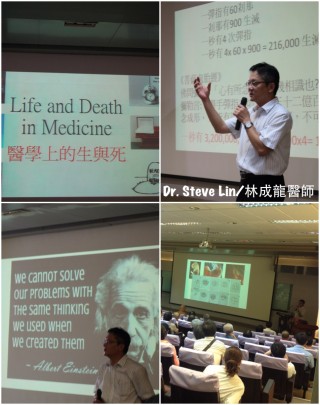
Dr. Steve Line gave a lecture during a death and dying workshop hosted by Heruka Center, National Cheng Kung University, Tainan City, Taiwan, July 2014. Photo courtesy of FPMT Taiwan.
Ven. Thubten Osel, director of Jinsiu Farlin, reported on the events happening at the three centers – Heruka Center, Jinsiu Farlin and Shakyamuni Center – that comprise FPMT Taiwan:
Heruka Center
Buddhist Education – Satellite Program
Last year, Heruka Center expanded its education program to neighboring city Tainan, where we continue to have a steady and thriving group of students attending the weekend class on tenets taught by Geshe Tashi Tsethar, resident teacher of Heruka Center in Kaohsiung.
Together with FPMT Taiwan, Heruka Center launched an annual 100 million Tara mantra marathon from May 24 – July 4, 2014, covering the entire Saka Dawa month, with specific dedications for Lama Zopa Rinpoche and His Holiness the Dalai Lama. What was originally meant to be just an individual center’s Saka Dawa practice ended up to become an international FPMT endeavor, with more than 900 people from 22 countries and 14 FPMT centers taking part. Together we accumulated 9,780,941 Tara mantras.
Even though what had been achieved was less than 10% of our goal, it still caused goose bumps to think of how more than 900 people from across the globe did the same practice with the same motivation and dedicated for the very same purpose during the auspicious month of Saka Dawa! On behalf of all of us who participated in the Tara mantra marathon, FPMT Taiwan presented a letter to His Holiness on July 6 and another letter on July 7 to Lama Zopa Rinpoche, explaining and offering our Saka Dawa practice completely dedicated for them.
Death and Dying Seminar
On July 19, 2014, Heruka Center organized a full-day death and dying seminar in a lecture hall in National Cheng Kung University which was attended by over 150 people. Dr. Steve Lin, chairman of FPMT Taiwan and director of the medical research department in Kaohsiung Medical University, presented the process of birth and reincarnation with plenty of medical data and visual aids which were both informative and entertaining. Geshe Tsethar spoke on the dying process, the intermediate state, taking rebirth, as well as the practice of the five powers. The seminar was so well received that Heruka Center is now planning a second one in October 2014, when both speakers will touch on issues such as terminal diseases, karma and Buddhist healing meditation.
Jinsiu Farlin
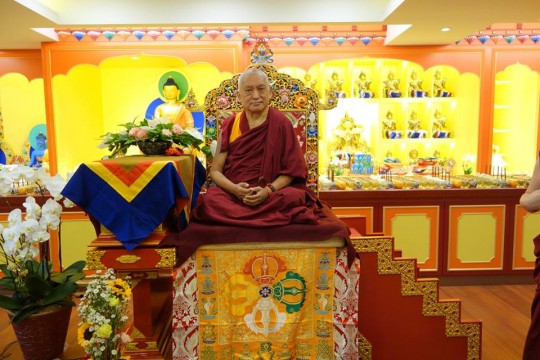
Lama Zopa Rinpoche in the newly renovated gompa of Jinsiu Farlin, Taipei, Taiwan, April 2014. Photo courtesy of FPMT Taiwan.
Jinsiu Farlin received news on Lama Zopa Rinpoche’s arrival on April 2014 on very short notice. Rinpoche’s short visit was not only a big surprise to everyone, his arrival in the airport – an hour earlier than scheduled – was an even bigger surprise! There were only a few students waiting in the airport at that time. The bouquet to welcome Rinpoche was not there, the car to pick up Rinpoche was not there, and the transport to pick up Rinpoche’s entourage was not there too! News about Rinpoche’s early arrival started to spread, and we began seeing students running toward the lounge from the arrival hall entrances and car park. It reached the point that whenever we saw someone running in the hall, we could be quite sure that that person was coming to receive Rinpoche! There were only about 10 students in the beginning, but slowly as people rushed in, we ended up having nearly a hundred students greeting Rinpoche in the airport.

Vens. Drolkar and Gyaltsen painting the wall during minor renovations at Shakyamuni Center, Taichung City, Taiwan, 2014. Photo courtesy of FPMT Taiwan.
During Rinpoche’s one week’s stay in Taipei, he met the members of the FPMT Taiwan board, gave Hayagriva long life Initiation, conducted the opening ceremony for the completely renovated center and did a few private pujas for the center. Both the initiation and opening ceremony were attended by nearly 250 people. Many old students returned, and there were many new faces too. Rinpoche was very pleased with the renovations, spending time going through each floor and checking out every corner.
During the opening ceremony, Rinpoche emphasized the importance of the existence of a center. “There is a BIG difference between working in a center and working in a company,” Rinpoche began. “When you work in a company, even though you make money, it doesn’t become purification unless you work with compassion. But, when you work in a center – the center gives teaching, educates people about reincarnation, karma, taking refuge, avoiding negative karma, practicing good karma, abiding in vows, keeping precepts, or gives Mahayana teachings, like generating compassion for sentient beings, practicing bodhichitta and so forth. When you work in a center, which educates sentient beings by giving teachings, it purifies the past negative karma to be born in the lower realms. It purifies that. And it makes serving sentient beings and serving the teachings of Buddha with compassion happen. So through the center, it helps to create morality and practice; it helps to achieve higher rebirth.”
Even though it was a short visit, Rinpoche’s presence itself rejuvenated and inspired everyone to want to practice Dharma and attend Dharma classes and prayers. These days we continue to see more members attending the center’s activities and more people are inspired to serve the center.
Shakyamuni Center
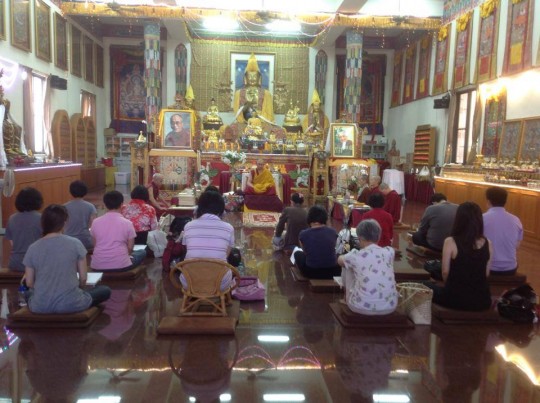
Geshe Gyatso leads lam-rim meditation at Shakyamuni Center, Taichung City, Taiwan, 2014. Photo courtesy of FPMT Taiwan.
In March 2014, Shakyamuni Center in Taichung thanked its outgoing director, Ven. Gyalten, a Taiwanese monk ordained by Choden Rinpoche, for his two years of service. During his stay, he did a minor renovation and adorned the main prayer hall with newly framed thangkas of the 16 Arhats and Pandits.
The center then welcomed on board its new director Ven. Drolkar, a Taiwanese nun ordained by Lama Zopa Rinpoche in 1995. Ven. Drolkar recently initiated a monthly lam-rim meditation weekend retreat led by the resident teacher, Geshe Ngawang Gyatso, and commenced yarne (summer retreat) with three other nuns in the center.
Mandala brings you news of Lama Zopa Rinpoche and of activities, teachings and events from over 160 FPMT centers, projects and services around the globe. If you like what you read on Mandala, consider becoming a Friend of FPMT, which supports our work.
- Tagged: fpmt taiwan, heruka center, jinsiu farlin, shakyamuni center
- 0
21
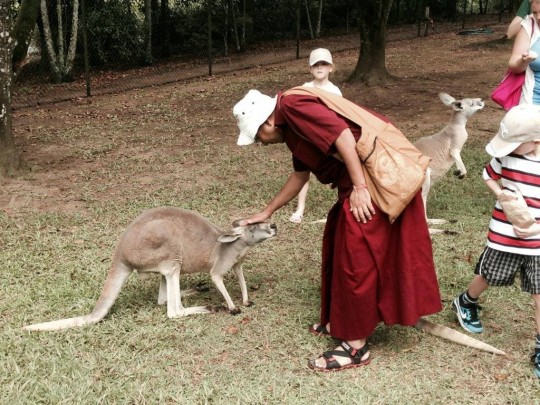
Geshe Sherab blessing a kangaroo, Australia Zoo, Brisabane, Australia, March 2014. Photo courtesy of Langri Tangpa Centre.
“Langri Tangpa Centre near Brisbane, Australia has had a feast of amazing international teachers and events this year,” reports student Carolyn Mason. “Maybe it is the blessing of the center’s wonderful new altar put in last year, carefully following advice from Lama Zopa Rinpoche on design and statues, which has been much appreciated by all attending these activities.”
“Ven. Robina Courtin was here in June and presented to a packed gompa – over 130 on her first night. Her directness, compassion and humor on practicing in everyday life was appreciated by many who had come to the center for the first time. Attracting new people, many of who are younger, is a very encouraging trend noted this year.
“There were very young people in the gompa for the center’s first ever Family Pageant to celebrate Saka Dawa. There was storytelling and rejoicing at the birth of the Buddha and bath offering to the baby Buddha by the children.
“The center’s baby Buddha had been blessed by Khadro-la [Rangjung Neljorma Khadro Namsel Drönme] on her visit in April when she spontaneously provided special advice on how to do the water offering ceremony. Her visit and one-evening teaching was followed by Khen Rinpoche Geshe Tashi Tsering giving a Great Chenrezig initiation and then Ven. Thubten Chodron giving a one-night teaching at the center, all within the space of six days!
“In late March, Geshe Sherab provided the center with the opportunity to offer the eight Mahayana precepts from a qualified lama for the first time. His teachings, including on the four immeasurables, were given to audiences of over 100 people. The director took him on a visit to Australia Zoo, founded by the late Steve Irwin, where Geshe Sherab made new friends (see photo above).
“In mid-March the Maitreya Loving Kindness Tour was very well attended and the talk on the nature of the relics provided a wonderful perspective on their significance and power. In mid-February the artisan Tibetan monks from Tashi Lhunpo monastery created a spectacular Medicine Buddha sand mandala, commencing with a Medicine Buddha puja.
“After a short mid-year break, the center will then contribute to the Australian visit of Lama Zopa Rinpoche, with the Great Chenrezig initiation at our sister center, Chenrezig Institute, and then teachings and initiations in Bendigo.”
Mandala brings you news of Lama Zopa Rinpoche and of activities, teachings and events from over 160 FPMT centers, projects and services around the globe. If you like what you read on Mandala, consider becoming a Friend of FPMT, which supports our work.
- Tagged: geshe sherab, langri tangpa centre, ven. robina courtin
- 0
“So far, 2014 has proved a busy year for Maitreya Loving Kindness Tour [a collection of over 1,000 Buddhist relics],” reports the tour’s Michael Fouts. ”There have been relic events throughout Mexico, US, Canada, Australia, New Zealand, Malaysia, Belgium, France, Denmark and Finland.
“The relics were displayed in Rennes, France at the Centre Culturel Bouddhique de Rennes, which is a very special and unique place because all of the Buddhist schools in Rennes – Zen, Drukpa, Rigpa and Kagyü – take turns each week to use the center for group practices. When the holy relics came to Rennes in July this year, it was the very first time that all Buddhist traditions worked together in a joint simultaneous effort.
“At every relic event around the world visitors are invited to offer bathing water to a small statue of the baby Buddha. As they offer the healing water, they think of healing and purifying the bodies and minds of themselves and others. There is a visualization prayer they can use as a guide. Lama Zopa Rinpoche first advised this practice for events back in 2005 and since then, thousands and thousands of visitors around the world have created this pure imprint in their minds.
“While in in Oregon, US, the team squeezed in a trip between scheduled relic events to a high-security prison in Salem, the state’s capitol. Around 50 prisoners came to view the relics, read the Golden Light Sutra, offer bathing water to the baby Buddha and write the Sanghata Sutra in gold ink. Some prisoners left the room completely overwhelmed by the loving energy emanating from the holy relics.
“In Malaysia, there were events in both Penang and Kuala Lumpur, hosted by local FPMT centers. All events were very well attended. Volunteers at both centers all worked very hard to create beautiful displays and offerings.
“On July 29 we launched a new blog so that the many inspiring stories and photos from around the world may be easily shared. Rejoice!”
Mandala brings you news of Lama Zopa Rinpoche and of activities, teachings and events from over 160 FPMT centers, projects and services around the globe. If you like what you read on Mandala, consider becoming a Friend of FPMT, which supports our work.
- Tagged: maitreya loving kindness tour
- 0
18
In February 1990, Lama Zopa Rinpoche gave a series of teachings as part of the Third Enlightened Experience Celebration, which took place in Bodhgaya, India. His discourse was based on the 15th-century text Opening the Door of Dharma. During the teachings, Lama Zopa Rinpoche described how he came across the text in his late twenties and what it meant to him:
“In 1974, while I was staying in the cave of the previous Lawudo Lama in the Solu Khumbu region of Nepal, I decided to check through all the texts that had belonged to him. They were mostly Nyingma texts relating to the practices of various deities, but there was one text that is a fundamental practice of all four Tibetan sects. The text I found was Opening the Door of Dharma: The Initial Stage of Training the Mind in the Graduated Path to Enlightenment.
“A collection of the advice of many Kadampa geshes, Opening the Door of Dharma is by Lodrö Gyaltsen, a disciple of both Lama Tsongkhapa and Khedrub Rinpoche, one of Lama Tsongkhapa’s two spiritual sons. This text describes the initial stage of thought transformation, or mind training – in other words, the first thing to practice if you want to practice Dharma.
“Only when I read this text did I come to know what the practice of Dharma really means. During all the years of my life up until then I had not known. Practicing Dharma is usually regarded as reading scriptures, studying, memorizing, debating, saying prayers, performing rituals, and so forth. It was only when I read this text that I found out how to practice Dharma. I was very shocked that all my past actions had not been Dharma. When I checked back, all those past years of memorizing and saying prayers were not Dharma. From all those years, nothing was Dharma. …”
Rinpoche’s discourse on Opening the Door of Dharma can be read in the book The Door to Satisfaction, edited by Vens. Ailsa Cameraon and Robina Courtain and published by Wisdom Publications. A PDF of the “Foreward” by Kirti Tsenshab Rinpche, “Editor’s Preface” and “Prologue” is available from Wisdom online. The “Prologue” includes Rinpoche’s account of his education, meeting Lama Yeshe and returning to Lawudo as well as the significance of his discovery of Opening the Door of Dharma.
Lama Zopa Rinpoche is the spiritual director of the Foundation for the Preservation of Mahayana Tradition (FPMT), a Tibetan Buddhist organization dedicated to the transmission of the Mahayana Buddhist tradition and values worldwide through teaching, meditation and community service.
13
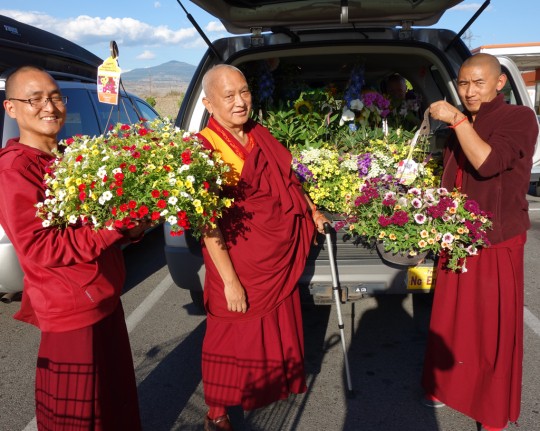
Lama Zopa Rinpoche after shopping for flowers for offering with Vens. Sherab and Sangpo, Washington, US, July 2014. Photo by Ven. Roger Kunsang.
“In the lam-rim, or graduated path to enlightenment, the first meditation outline is the root of the path: how to devote to the virtuous friend. Why is guru devotion the root of the path to enlightenment? Enlightenment is like a ripe fruit, the path to enlightenment is like the trunk of a tree, and guru devotion is like the root of the tree. From the root of guru devotion, the trunk of the path grows in our mind and bears the fruit of enlightenment. Whether or not we can start to develop the path to enlightenment in our mind in this life is determined by our practice of guru devotion,” Lama Zopa Rinpoche teaches in The Heart of the Path.
“Proper devotion to the guru, or virtuous friend, is the root of all success, from success in this life up to enlightenment, just as the trunk, branches, leaves and fruit of a tree depend upon its root. Or we can think that guru devotion is like the fuel in a car or a plane, without which the vehicle cannot take us where we want to go. Without guru devotion, nothing happens – no realizations, no liberation, no enlightenment – just as without the root of a tree there can be no trunk, branches, leaves, or fruit. Everything, up to enlightenment, depends on guru devotion.
“Guru devotion is the root not only of ultimate success, achieving full enlightenment and bringing sentient beings to the ultimate happiness of liberation and enlightenment, but also of temporary success and happiness. This practice is the foundation of the development of the whole path to enlightenment, as well as the foundation of all happiness. Since everything comes from the practice of guru devotion, it is called the root of the path. …”
You can read more in this excerpt from “Why Do We Need a Guru?,” the first chapter of the book The Heart of the Path: Seeing the Guru as Buddha by Lama Zopa Rinpoche, published by the Lama Yeshe Wisdom Archive.
Learn more about FPMT spiritual director Lama Zopa Rinpoche and his beneficial activities by visiting Rinpoche’s homepage, where you will find links to Rinpoche’s schedule, new advice, recent video, photos and more.
- Tagged: guru devotion, lam-rim, lama zopa rinpoche
- 0
12
Geshe Lamsang’s Heart Advice
In the July-September 2014 issue of Mandala, Steve Milton, director of Centro Nagarjuna Valenica in Spain, shared that on “Tuesday evenings at Centro Nagarjuna Valencia in Spain, Geshe Lamsang, the center’s resident geshe, gives an hour-and-a-half talk or teaching. … A few years ago, I started to call the Tuesday talk ‘Heart Advice.’ And it really is just that, depending on who comes to the talk or what Geshe-la has on his mind, he will give spontaneous heartfelt advice that is inspiring for new comers and older students alike.”
Mandala shared an excerpt on it’s website:
What must we do to free ourselves completely from cyclic existence? Buddha gave instructions as to what we should abandon and what we should practice, that is to say, he indicated which causes and their corresponding effects we should eliminate and what we should try to achieve. The two causes and their effects to eliminate are the truth of suffering and the truth of the origin (of suffering), and the two causes and their results we need to obtain are the truth of cessation and the truth of the path that leads to cessation. Buddha himself emphasized that it is up to us to carry out this work on ourselves. Through our effort we will free ourselves from samsara. In this way, we are our own enemy and own best friend. It may seem contradictory, but both are aspects of our mind.
If we allow ourselves to be dragged along by negative emotions, this will cause us problems. As we continue to create causes to experience suffering, we become our own enemy. Yet we can be our own best friend by eliminating the origin of suffering and by following the path to achieve this. In this way, we will progress on the path and eliminate the causes of all our problems. There are six places where we can go after this life and the means by which we can avoid being reborn in the three negative places has already been explained. As humans we have already avoided being reborn in the lower realms but we still experience unwanted situations because this is the nature of cyclic existence (samsara). If we do not want to be reborn again into samsara, we should follow Buddha’s instructions. For this purpose Buddha gave teachings which can be grouped into the three “turnings” or “wheels of Dharma.” …
From Mandala July-September 2014
“The Medicine Buddha encompasses all the buddhas. This means that when we practice the seven-limb prayer and make offerings with the seven limbs, we receive the same merit as we would if we had made offerings to all the buddhas. Similarly, when we recite the mantra of Medicine Buddha, we collect unbelievable merit just as when we offer the seven-limb practice to Medicine Buddha,” Lama Zopa Rinpoche teaches in “The Benefits of Medicine Buddha Practice.”
“To recite the Medicine Buddha mantra brings inconceivable merit. Manjushri requested the eight tathagatas (Guru Shakyamuni Buddha and the seven Medicine Buddhas) to reveal a special mantra that would make the prayers they (the eight tathagatas) made in the past (prayers to be able to actualize the happiness of sentient beings by attaining the path to enlightenment and pacifying various problems, to be able to see all the buddhas, and for all wishes to be quickly realized) to quickly come to pass, especially for those sentient beings born in the time of the five degenerations who have small merit and who are possessed and overwhelmed by various diseases and spirit harms.
“During that time, all the eight tathagatas, in one voice, taught the Medicine Buddha mantra. Therefore, if you recite the mantra every day, the buddhas and bodhisattvas will always pay attention to you, and they will guide you. Vajrapani, owner of the secrets, and the four guardians will always protect and guide you. All your negative karmas will be pacified, and you will never be born in the three lower realms. Even just hearing a recitation of the names of the eight tathagatas pacifies all diseases and spirit harms – even spirit harms that arise as a condition of disease – and all your wishes are fulfilled. …”
From the FPMT Education Services’ booklet “The Benefits of Medicine Buddha Practice” by Lama Zopa Rinpoche. For more on Medicine Buddha, see “Medicine Buddha Practice for Sickness and Poor Health.”
More information, photos and updates about FPMT spiritual director Lama Zopa Rinpoche can be found on Rinpoche’s homepage. If you’d like to receive news of Lama Zopa Rinpoche via email, sign up to Lama Zopa Rinpoche News.
- Tagged: lama zopa rinpoche, medicine buddha
- 0
- Home
- News/Media
- Study & Practice
- About FPMT Education Services
- Latest News
- Programs
- New to Buddhism?
- Buddhist Mind Science: Activating Your Potential
- Heart Advice for Death and Dying
- Discovering Buddhism
- Living in the Path
- Exploring Buddhism
- FPMT Basic Program
- FPMT Masters Program
- FPMT In-Depth Meditation Training
- Maitripa College
- Lotsawa Rinchen Zangpo Translator Program
- Universal Education for Compassion & Wisdom
- Online Learning Center
- Prayers & Practice Materials
- Overview of Prayers & Practices
- Full Catalogue of Prayers & Practice Materials
- Explore Popular Topics
- Benefiting Animals
- Chenrezig Resources
- Death & Dying Resources
- Lama Chopa (Guru Puja)
- Lama Zopa Rinpoche: Compendium of Precious Instructions
- Lama Zopa Rinpoche: Life Practice Advice
- Lama Zopa Rinpoche Practice Series
- Lamrim Resources
- Mantras
- Prayer Book Updates
- Purification Practices
- Sutras
- Thought Transformation (Lojong)
- Audio Materials
- Dharma Dates – Tibetan Calendar
- Translation Services
- Publishing Services
- Teachings and Advice
- Find Teachings and Advice
- Lama Zopa Rinpoche Advice Page
- Lama Zopa Rinpoche: Compendium of Precious Instructions
- Lama Zopa Rinpoche Video Teachings
- ༧སྐྱབས་རྗེ་བཟོད་པ་རིན་པོ་ཆེ་མཆོག་ནས་སྩལ་བའི་བཀའ་སློབ་བརྙན་འཕྲིན།
- Podcasts
- Lama Yeshe Wisdom Archive
- Buddhism FAQ
- Dharma for Young People
- Resources on Holy Objects
- Ways to Offer Support
- Centers
- Affiliates Area
- Teachers
- Projects
- Charitable Projects
- Make a Donation
- Applying for Grants
- News about Projects
- Other Projects within FPMT
- Support International Office
- Projects Photo Galleries
- Give Where Most Needed
- FPMT
- Shop
Subscribe to FPMT News
Translate*
*powered by Google TranslateTranslation of pages on fpmt.org is performed by Google Translate, a third party service which FPMT has no control over. The service provides automated computer translations that are only an approximation of the websites' original content. The translations should not be considered exact and only used as a rough guide.The whole thing, so many practices, all come down to live the daily life with bodhicitta motivation to put all the effort in that whatever you do. This way your life doesn’t get wasted and it becomes full of joy and happiness, with no regrets later, especially when you die and you can die with a smile outside and a smile in the heart.







